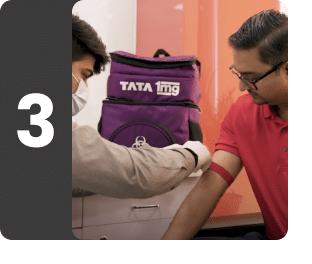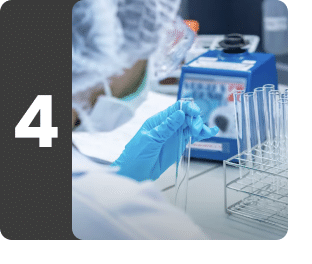Basic Vital Organ Screen near me in Gurgaon
Understanding Basic Vital Organ Screen in Gurgaon
What is Basic Vital Organ Screen in Gurgaon?
Basic vital organ screen comprises a group of tests to evaluate the overall health of an individual. It is used to detect disorders such as diabetes, thyroid disorders, kidney disease and liver disease through some markers. The package also includes a complete evaluation of blood parameters which can give clue for a number of other diseases. The package can be ordered as a part of routine check up to monitor general health. The package is also useful for the patients already suffering from some diseases such as diabetes, kidney diseases, liver disease, thyroid diseases, and anemia to check the progress of treatment.
What does Basic Vital Organ Screen measure?
Contains 25 tests
Serum Creatinine
A Serum Creatinine test measures the level of creatinine in the blood. Creatinine is a byproduct of muscles’ wear and tear during energy production. The kidneys remove it from the body by filtering from the blood and releasing it into the urine. Therefore, blood creatinine levels can be an indicator to know how well the kidneys are working.
Know more about Serum Creatinine

CBC (Complete Blood Count)
A CBC (Complete Blood Count) test evaluates red blood cells (RBCs), white blood cells (WBCs}, and platelets. Each of these blood cells performs essential functions–RBCs carry oxygen from your lungs to the various body parts, WBCs help fight infections and other diseases, and platelets help your blood to clot–so determining their levels can provide significant health information. A CBC test also determines the hemoglobin level, a protein in RBC that carries oxygen from the lungs to the rest of your body. Evaluating all these components together can provide important information about your overall health.
Know more about CBC (Complete Blood Count)
Absolute Lymphocyte Count
-
T lymphocytes (T cells): T cells control your body’s immune system response and directly attack and kill infected cells and tumor cells.
-
B lymphocytes (B cells): B cells make antibodies. Antibodies are proteins that target viruses, bacteria, and other foreign pathogens.
An Absolute Lymphocyte Count test measures the total number of lymphocytes in the blood. Lymphocytes are a type of white blood cells that play an important role in your immune system and help your body fight disease and infection. There are two main types of lymphocytes:
Lymphocytes help your immune system remember every antigen (a foreign substance) it comes in contact with. After an encounter, some lymphocytes turn into memory cells. When these memory cells run into an antigen again, they recognize it and quickly respond. It is also the reason why getting vaccinated helps prevent certain diseases.
Absolute Neutrophil Count
An Absolute Neutrophil Count test measures the percentage of neutrophils per microliter of blood. Neutrophils are a type of WBC and play an integral part in the body's immune system. They help fight off bacterial infections in the body by identifying and destroying foreign invaders, such as disease-causing microorganisms.
Differential leukocyte Count
- Differential Neutrophil Count
- Differential Lymphocyte Count
- Differential Monocyte Count
- Differential Eosinophil Count
- Differential Basophil Count
There are five types of WBCs: neutrophils, lymphocytes, monocytes, eosinophils, and basophils. A Differential leukocyte Count test measures the percentage of each type of WBC in the blood. Leukocytes or WBCs are produced in the bone marrow and defend the body against infections and diseases. Each type of WBC plays a unique role to protect against infections and is present in different numbers.
This further contains
Red Blood Cell Count
A Red Blood Cell Count test measures the total number of red blood cells in your blood. RBCs are the most abundant cells in the blood with an average lifespan of 120 days. These cells are produced in the bone marrow and destroyed in the spleen or liver. Their primary function is to help carry oxygen from the lungs to different body parts. The normal range of RBC count can vary depending on age, gender, and the equipment and methods used for testing.
Platelet Count
A Platelet Count test measures the average number of platelets in the blood. Platelets are disk-shaped tiny cells originating from large cells known as megakaryocytes, which are found in the bone marrow. After the platelets are formed, they are released into the blood circulation. Their average life span is 7-10 days.
Platelets help stop the bleeding, whenever there is an injury or trauma to a tissue or blood vessel, by adhering and accumulating at the injury site and releasing chemical compounds that stimulate the gathering of more platelets. A loose platelet plug is formed at the site of injury and this process is known as primary hemostasis. These activated platelets support the coagulation pathway that involves a series of steps, including the sequential activation of clotting factors; this process is known as secondary hemostasis. After this step, there is a formation of fibrin strands that form a mesh incorporated into and around the platelet plug. This mesh strengthens and stabilizes the blood clot so that it remains in place until the injury heals. After healing, other factors come into play and break the clot down so that it gets removed. In case the platelets are not sufficient in number or not functioning properly, a stable clot might not form. These unstable clots can result in an increased risk of excessive bleeding.
Total Leukocyte Count
A Total Leukocyte Count test measures the numbers of all types of leukocytes, namely neutrophil, lymphocyte, monocyte, eosinophil, and basophil, in your blood. Leukocytes or WBCs are an essential part of our immune system. These cells are produced in the bone marrow and defend the body against infections and diseases. Each type of WBC plays a unique role to protect against infections and is present in different numbers.
Absolute Basophil Count
An Absolute Basophil Count test measures the total number of basophils in the blood. Basophils are small, spherically-shaped cells that originate from bone marrow and make up almost 1% of the total white blood cells in the body. They attack a foreign substance and release proteins like histamine and heparin to destroy harmful substances, such as allergens, pathogens, or parasites. Histamine helps widen the blood vessels and make space for more immune cells to come to the site of infection or injury, whereas heparin acts as a blood-thinning agent and helps to avoid blood clotting at that site.
Absolute Monocyte Count
An Absolute Monocyte Count test measures the total number of monocytes in the blood. Monocytes are a type of WBC that originate from bone marrow and travel to different tissues via the blood. Once they are inside the tissue, these cells get converted to macrophages (a type of cell that digest harmful substances). Monocytes are the second line of defense mechanism of the human body after neutrophils. These cells are also responsible for the removal of injured or dead cells, microorganisms, and other insoluble particles from the blood.
Absolute Eosinophil Count
An Absolute Eosinophil Count test measures the number of eosinophils in the blood and provides important information about the functioning of the immune system. Eosinophils originate from bone marrow and have a lifespan of 8-18 hours. These cells are involved in fighting certain types of infections and responding to allergic reactions in the body. The eosinophils have varied functions including the physiological role in organ formation, such as the development of post-gestational mammary glands. Other functions of these cells include movement to the inflammation areas, trapping substances, killing cells, and bactericidal and antiparasitic activities. They also help in the treatment of immediate allergic reactions and modulation of inflammatory responses. By measuring the number of eosinophils in the blood, this test provides important information about the functioning of the immune system.
Hematocrit
A Hematocrit test measures the proportion of red blood cells (RBCs) in your blood as a percentage of the total blood volume. It is a crucial part of a complete blood count (CBC) and helps in assessing your blood health. RBCs are responsible for carrying oxygen from the lungs to different parts of the body. The hematocrit test provides valuable information about your blood's oxygen-carrying capacity.
Higher-than-normal amounts of RBCs produced by the bone marrow can cause the hematocrit to increase, leading to increased blood density and slow blood flow. On the other hand, lower-than-normal hematocrit can be caused by low production of RBCs, reduced lifespan of RBCs in circulation, or excessive bleeding, leading to a reduced amount of oxygen being transported by RBCs. Monitoring your hematocrit levels is essential for diagnosing and managing various blood-related disorders.
Mean Corpuscular Volume
A Mean Corpuscular Volume test measures the average size of your red blood cells, which carry oxygen through your body. This test tells whether your RBCs are uniform or vary significantly in size.
Mean Corpuscular Hemoglobin
An MCH test measures the average amount of hemoglobin in a single red blood cell (RBC). Hemoglobin is an iron-containing protein in RBCs, and its major function is to transport oxygen from the lungs to all body parts. This test provides information about how much oxygen is being delivered to the body by a certain number of RBCs.
Mean Corpuscular Hemoglobin Concentration
An MCHC test measures the average amount of hemoglobin in a given volume of RBCs. MCHC is calculated by dividing the amount of hemoglobin by hematocrit (volume of blood made up of RBCs) and then multiplying it by 100.
Mean Platelet Volume
An MPV test measures the average size of the platelets in your blood. Platelets are disk-shaped tiny cells originating from large cells known as megakaryocytes, which are found in the bone marrow. After the platelets are formed, they are released into the blood circulation. Their average life span is 7-10 days.
Platelets help stop bleeding whenever there is an injury or trauma to a tissue or blood vessel by adhering and accumulating at the injury site, and by releasing chemical compounds that stimulate the gathering of more platelets. After these steps, a loose platelet plug is formed at the site of injury, and this process is known as primary hemostasis. These activated platelets support the coagulation pathway that involves a series of steps including the sequential activation of clotting factors; this process is known as secondary hemostasis. After this, there is a formation of fibrin strands that form a mesh incorporated into and around the platelet plug. This mesh strengthens and stabilizes the blood clot so that it remains in place until the injury heals. After healing, other factors come into play and break the clot down so that it gets removed. In case the platelets are not sufficient in number or are not functioning properly, a stable clot might not form. These unstable clots can result in an increased risk of excessive bleeding.
PDW
RDW CV

Bilirubin Total
A Bilirubin Total examination quantifies the levels of total bilirubin in the body, encompassing both indirect (unconjugated) and direct (conjugated) bilirubin. Bilirubin, a yellowish waste substance, is primarily generated during the breakdown of aging red blood cells (RBCs) in the body. After their typical lifespan of 120 days, RBCs disintegrate in the liver, leading to the production of a substantial amount of bilirubin. It is crucial for this bilirubin to be eliminated from the body.
Know more about Bilirubin Total

RBS (Random Blood Sugar)
An RBS (Random Blood Sugar) test is done to measure the levels of glucose at any time of the day. This test provides a speedy diagnosis of diabetes. It is also helpful in identifying diabetic patients who require a supplementary dose of insulin in case of an emergency.
Know more about RBS (Random Blood Sugar)

TSH (Thyroid Stimulating Hormone) Ultrasensitive
A TSH (Thyroid Stimulating Hormone) Ultrasensitive test measures the levels of TSH hormone in the blood. TSH is produced by the pituitary gland located in the brain. Its function is to stimulate and regulate the functioning of the thyroid gland. It signals the thyroid gland to increase or decrease the production of thyroid hormones T3 and T4 (essential for regulating our body’s metabolism, temperature, heart rate, and growth) when their levels are low or high, respectively. Therefore, when the levels of T3 & T4 decrease, the pituitary gland is stimulated to release TSH. This high TSH level in turn stimulates the thyroid gland to release more thyroid hormones (T3 & T4); the vice-versa happens when the levels of thyroid hormones increase.
Know more about TSH (Thyroid Stimulating Hormone) Ultrasensitive
Book a Basic Vital Organ Screen test at home near me





Other tests









